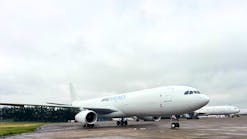The ground support industry, like the aviation industry as a whole, runs on tight margins. To ensure success and profitability, airlines, airports, and ground service support providers must be at the top of their respective games and look at all costs intently.
As the aviation industry continues to grow and change, several trends have emerged that are impacting how ground support equipment (GSE) is being acquired and financed.
Increased Profits Equals Increased Pressure
Airlines are back to record profit margins. With this success comes much needed, significant capital expenditures into new equipment and technology to continue to maintain safety and efficiency due to previously deferred equipment upgrades.
“Cash is a big issue right now as the airlines continue to generate significant revenue,” says Bill Banfield, national finance manager for the airport ground support equipment division at TCF Equipment Finance. “An all cash approach limits a customer’s flexibility in the future. This ‘feast or famine’ approach has failed in the past and forces companies to keep GSE well beyond its economic useful life. Operational parameters, government regulations, technology and a company’s financial situation can change. Incorporating flexibility into a fleet replacement strategy mitigates the unpredictable economic cycles that have plagued the airline industry in the past.”
As both airline travel increases and aircraft upgrades come to market, there is an increasing expectation for service providers to operate and add the newest and most innovative equipment to their fleet.
To do this, many ground support providers are looking to equipment leasing, rather than purchasing, as a financial solution to support their requirements.
“I think definitely for handling companies, leasing is almost an absolute,” Neil Bennett, managing director at Somerset Aviation Capital, says. “You have to do it and I think there’s definitely a trend in that direction. It’s sort of the business model in Europe, but I think they’re learning the benefits here in North America.”
The fact is, ground handling equipment typically lasts 10 to 20 years and holds its value quite well. Because this equipment has such a long lifespan, longer financing terms can be arranged, which in turn means low monthly payments that can deliver consistency and peace of mind to ground services providers.
For example, Ohio-based Summit Funding Group recently worked with one of the world’s largest ground handling providers to provide $20 million in financing for various types of ground handling equipment, including cargo loaders, deicers, push-back tractors, lavatory trucks, cargo dollies, electric belt loaders and re-fuelers, among others.
Summit’s client was bidding for new contracts, and needed to ensure that the most updated equipment was on hand. This strategy differentiated them from the competition, and put them in a position to service their potential contracts safely, reliably, and profitably.
“It all seems to come down to money, and what the monthly payment is, and I feel there’s a trend,” Bennett says. “It’s becoming more important to have use of the equipment at the lowest cost. That’s the key, and not ownership.”
While preparing their new contract bids, the client worked with Summit Funding to obtain quotes for leasing new equipment they needed over the next seven to ten years. Summit provided a monthly payment on various types of equipment, and the client was able to take that payment, add their target profit margin, and send their client a total fixed cost while bidding.
Through this strategy, Summit’s client is ensuring that they have access to the most updated equipment to service the contract, they’re preserving capital upfront, while also protecting their profit margin for the entire life of each contract.
“You get contracts that require you to start fairly quickly,” Bennett says. “There is no time to plan for capital expenditures. You can plan, and have a basic budget in mind for your expenditures, but in this industry, the airline industry, it’s a completely moving target.”
Alternatively, if a ground handling company decides to purchase their equipment outright, that company will face two challenges in the current market.
First, they will need to deploy a great deal of capital from the start, which can constrain working capital and be challenging in such a tight-margin industry.
“On the short term position, they have cash on hand so the general thinking is, ‘let’s spend it.’ They’re not in a cash preservation mode,” says Banfield. “Historically, when airlines had cash, they were buying down debt. Now, with cash flows reaching an all-time high, some airlines are purchasing all their assets and may not be looking at the big picture for the long term which is to understand the true cost of ownership over the lifecycle of an asset.”
Second, after several years, the equipment they purchase may become outdated, and often is not worth what they might have hoped. At that point, they are stuck with equipment that is obsolete, needs considerable maintenance, and is very expensive to replace.
As pressure increases to be equipped with the latest equipment, leasing continues to emerge as a flexible financial solution.
“When money is good, of course, people do tend to like to purchase outright,” Bennett says. “Although that’s a bit clouded because the money that they actually have in their bank account isn’t necessarily theirs. It’s their shareholders’ money, and shareholders require a lot more profits than finance companies do.”
Material/Technology Changes Prompting Increase in GSE Sales and Financing
Two new aircraft types have begun to emerge, the 787-9 and A350. Both are made of more composite materials than aluminum. While the new material will support better fuel efficiency and aerodynamics, the challenge is that composite materials can be damaged more easily and it’s difficult to detect if damage was done.
For ground support providers, this means that safety is more of a concern than ever before.
To be clear, it’s understood that safety is always the priority, and all ground support providers seek to maintain a zero accident record.
As aircraft material changes, many in the ground support industry will find that new equipment is necessary to maintain that pristine level of safety.
For example, the newest cargo loaders are being equipped with pressure sensitive sensors that will indicate if too much force is being used while docked against an aircraft.
This may sound counter-intuitive, but new technology and new GSE can be a prestige investment, especially in the FBO arena.
“Presentation of an FBO is first and foremost, well, I suppose behind safety, of course, which falls right in line with buying new equipment,” Bennett says. “So you get safety and you get presentation. That’s what the FBO needs to present. It’s a first-class operation dealing with private corporate jets.”
The need for these new, specific technologies is driving a number of trends forward in the equipment sales and financing sector. For example:
Operating leases timed with specific contracts
Based on the equipment’s long lifespan, ground handling equipment is easy to finance in a way that coincides with specific contracts. This is becoming increasingly popular among ground support companies. By arranging leases that align with specific contracts, a ground support provider will typically enjoy a very low monthly payment throughout the term, followed by the ability to either purchase the equipment at a later date or walk away from the equipment free and clear if the contract is not renewed or a new contract is not yet in place.
Increased used equipment sales
Companies that own outdated equipment with a need to get the newest technology are increasingly looking for support in finding buyers of their older assets to make room for new equipment. Summit Funding can help ground handling companies locate these buyers and help provide financing or lease solutions to help move the old equipment out.
“Used sales are typically driven by operational demands and location,” Banfield says. “If you have a very high demand area, it’s not feasible to put used GSE there. It wouldn’t make a lot of sense due to the unpredictable uptime. Conversely, if a location has only five to ten turns, it’s hard to justify and warrant new equipment for that application.”
More equipment refurbishing
Most all ground service providers that already own a large fleet of equipment try to maximize the life of their equipment. In order to do so, these companies need to refurbish their equipment to remain competitive and some of these new technology upgrades can be obtained during a simple refurbishment. For these situations, it’s advantageous to finance a refurbishment, which gives the company a stable monthly payment that they can expect, as opposed to a large up-front cost. This financing trend can help ground service providers to extend the life of equipment while also keeping their operating costs low.
Today’s ground service providers are increasingly looking toward solutions like the above in order to acquire newer advanced equipment, refurbish older outdated equipment, or get rid of older assets all together.
New GSE Finance Options
In addition to an increase in equipment leasing, leases that coincide with contracts, and refurbishment financings, there are other GSE finance options of note for today’s ground support providers. For example:
Longer finance terms
While traditional equipment leasing was thought of as a short-term option, GSE equipment is increasingly being financed over longer periods of time, often from 7 to 10 years. By extending the length of these equipment leases, companies are able to spread out their capital expenditures, resulting in more stable expenses that can contribute to more consistent profit margins.
Seasonal payments
Because some services within the ground support industry derive revenue seasonally, a new way to approach GSE financing is to match the cash flows of the seasonality with the lease payments. For example, companies that offer deicing tend to draw all of their revenue within six months of any given year. The practice came into use in the early 1900s for the purchase of agricultural equipment. In 1923, the Agricultural Credit Act was passed providing short-term and intermediate credit. This method of “pay when you can” or, when it’s the most opportune time, was typically referred to as a “harvest plan.”
“Simply put, get the equipment and supplies you need today then pay when your cash flows are at their greatest,” Banfield says.
Cost Savings Through Fleet Renewal
GSE fleet operators actually require less equipment as new, more reliable GSE is added. Reliable fleets no longer need redundant equipment to serve as backups while broken GSE is in the shop.
“When a fleet goes from a preventive to a reactive maintenance strategy, they will exponentially decrease the operating cost per hour,” says Banfield. “That will add additional savings to the operating budget that will, hopefully, flow over to the CapEx budget. From there, the renewal and replacement cycle gets even better for the GSE arena.”
In the end, airlines, ground handlers and FBOs need new equipment. The method of acquisition is becoming increasingly irrelevant with the multitude of options available.
“It’s utilization of the asset that the end user wants, not pride of ownership,” Banfield says. “I defy anybody to walk out on the tarmac and see somebody out there Turtle Waxing and Armor All-ing a tractor. It’s never going to happen.”
Overall, margins have increased, and the industry as a whole is reinvesting capital to make improvements. As this activity continues, ground handling professionals who stay on top of financing trends and make smart decisions with regard to how they acquire ground support equipment will thrive.






